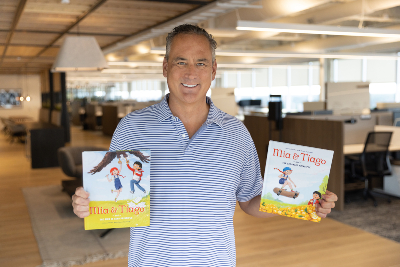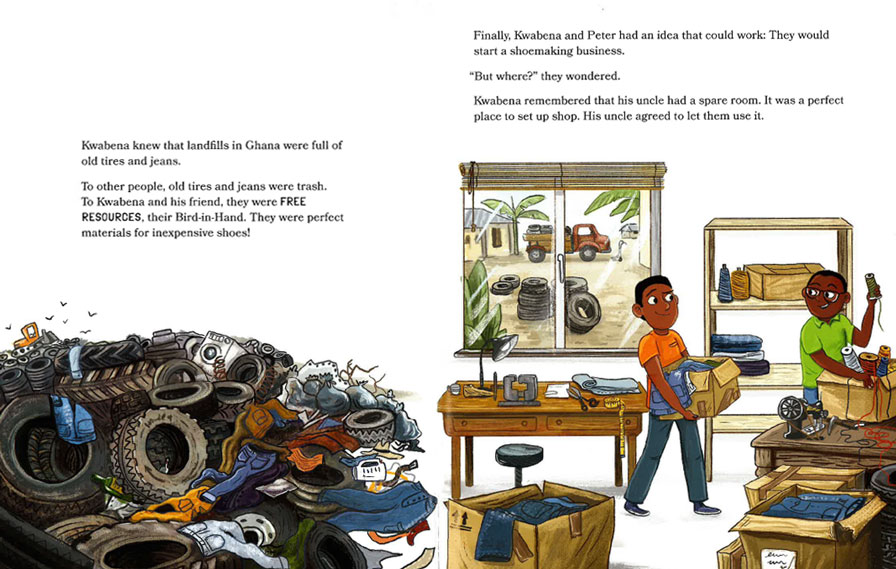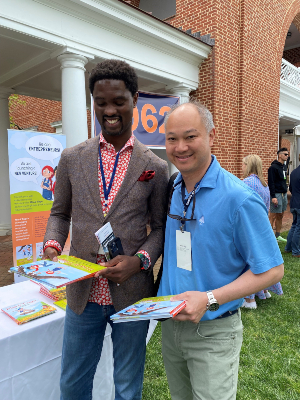New Book Series Takes Power of Effectuation to Kids
University of Virginia Darden School of Business Professor Saras Sarasvathy’s theory of Effectuation is a global phenomenon, the rare academic theory that seems to have equal influence in higher education and among individuals and organizations across the world.
One of the theory’s proponents and a vocal enthusiast of Effectuation in work and life is Doug Lebda (EMBA ’14), founder and CEO of LendingTree, the online marketplace for financial services he launched in 1996.
“In many ways Effectuation is a method like the scientific method, it’s a way of thinking and finding solutions; a method that can be applied to any area of life,” said Lebda. “I followed the Effectuation method before I knew about Effectuation, and now I am always applying those principles when making decisions.”
Now, thanks to the support of Lebda’s charitable foundation, Effectuation’s influence is poised to spread to a much younger generation.
"Imagine if science was only taught to the potential scientists. We would never get to the 20th century — so why are we teaching entrepreneurship only to the future entrepreneurs?"SARAS SARASVATHY
Lebda, a philanthropist with a keen interest in education, has helped launch Mia & Tiago, a new series of books aimed at school-aged children that teaches future founders how to think, make decisions and act like expert entrepreneurs.

LendingTree CEO Doug Lebda is an enthusiastic backer of Effectuation.
The series author, Gosia Glinska, associate director of research impact at Darden, is well versed in the power of Effectuation, having collaborated with Sarasvathy on various projects and seen the power of the curriculum in the hands of students building ventures at Darden.
Like many, Glinska has long been struck by the accessibility and universality of the theory, which offers easy to understand tools and practices to help jumpstart and navigate the venture creation process. She has also watched as Effectuation made the jump beyond venture creation into all manner of problem solving. So, when talking to teachers of school-aged children who faced the challenge of teaching entrepreneurial, creative problem solving to young people, Glinska had a solution.
“I would see teachers in elementary schools teaching business plan writing as a way to teach kids to think like entrepreneurs, which I think is not really the best method,” said Glinska. “I knew Effectuation was such a highly teachable and learnable methodology, and I just thought: ‘I’m going to bring this time-tested and empowering method to kids.’”
That was the genesis for what would become the series of books starring Mia and Tiago, two elementary school-age would-be entrepreneurs who use the principles of Effectuation to solve problems, better understand their own abilities and learn to think like expert entrepreneurs. Each book takes one of Sarasvathy’s principles as the jumping off point for Mia and Tiago as they seek to enter the “Moonshots Contest” at their school, which involves getting started on the creation of a venture.
The stories are deceptively simple and empowering, like Sarasvathy’s principles, and illustrated in bright colors by artist Tomasz Pląskowski.
A Vision Comes to Life
For Sarasvathy, who has long believed in the need for entrepreneurial instruction and introduction in curriculums outside of higher education, the books are a delightful extension of the theory she first penned nearly 30 years ago.
“For years, I have been telling people that we should teach entrepreneurship the way we teach science,” said Sarasvathy. “Imagine if science was only taught to the potential scientists. We would never get to the 20th century — so why are we teaching entrepreneurship only to the future entrepreneurs?”
For Sarasvathy, entrepreneurship — particularly when taught using the principles of Effectuation — encompasses more than its popular shorthand of business creation. It’s about harnessing one’s own abilities, engaging others for help and support, mitigating and overcoming failures and planning for the future —valuable skills for individuals of all ages.
While Sarasvathy credits Glinska with the idea of a series of books for children, she had long bandied about the idea of a book on “effectual life” with Lebda.
When Glinska proposed the children’s books, Sarasvathy said she knew the LendingTree Foundation could be a valuable partner. Kim Gorsuch, a former LendingTree employee, meanwhile, had started a children’s book publishing venture, Weeva, and had approached the LendingTree Foundation about potential projects.
“It was just a confluence of things that all came together,” said Sarasvathy.
Bringing Ideas to Young Learners
Glinska, who holds an M.F.A. from UVA and has taught fiction writing at the University, immersed herself in children’s literature before writing the first book, Mia & Tiago and the Bird in Hand Principle.
As Mia and Tiago consider their entry into the Moonshots contest, they are guided by a talking, vest and bow tie-wearing Eagle named Edison, who introduces the first principle of Effectuation while citing an example of real-life entrepreneurs who started a venture using what they had access to — in this case, the Ghana-based shoe business Kolikowear. The first book concludes with a recap of the bird-in-hand principle and its role in an entrepreneurial journey. Glinska has confidence the concepts will click with even young children.

The book tells the story of Kolikowear to illustrate the entrepreneurial value of starting with what you already have. Art by Tomasz Pląskowski.
"I see Effectuation becoming a life-long mindset, empowering kids to be entrepreneurial, creative and innovative, which will help them thrive in the 21st century economy."GOSIA GLINSKA
Said Glinska, “We’ve tested the books with fifth graders in an elementary school in North Carolina, and rising third-graders in Charlottesville. We know that kids are able to fully grasp the principles of Effectuation.”
Glinska’s goal for the books, similar to Sarasvathy’s, is to show that entrepreneurship is learnable, and that anyone has the power to create something great.
“This is also a way to teach kids how to solve problems,” said Glinska. “I see Effectuation becoming a life-long mindset, empowering kids to be entrepreneurial, creative and innovative, which will help them thrive in the 21st century economy.”
Mia & Tiago and the Bird in Hand Principle and Book Two, Mia & Tiago and the Lemonade Principle, are available on amazon.com. Glinska has completed the third book, Mia & Tiago and the Affordable Loss Principle and the fourth, Mia & Tiago and the Entrepreneurial Ask.

Darden alumni picked up copies during Darden Reunion Weekend.
The backers of the project — including Glinska, Sarasvathy, the LendingTree Foundation and Weeva — hope to get the books into the hands of children, parents and teachers. Although there has been only limited promotion of the books so far, the global effectuation network is already clamoring for translated versions, with Sarasvathy receiving notes and requests from well-wishers around the world.
And what does Sarasvathy think of the latest, and likely most colorful, iteration of the theory she first articulated as part of a dissertation on expert entrepreneurs decades ago?
“I am just thoroughly delighted. I love the characters, the content, the beauty of the drawings,” said Sarasvathy. “It’s just not one of those things you expect to happen in your career. How many academic theories have made their way to children’s books?”
To learn more about the Mia & Tiago picture book series and order hard copies, visit www.miatiagobooks.com. E-books and hard-cover copies are available on amazon.com.
Originally published here by the Darden School
.png?width=200&height=82&name=Effectuation%20Extended%20Logo%20(200%20%C3%97%2082%20px).png)